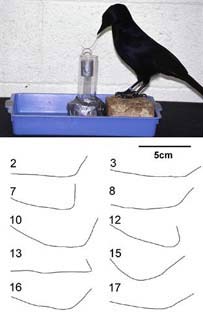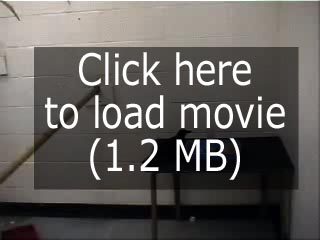Our experiments on tool selectivity did not examine whether the crows understood how their tools worked. To do this, we gave our subjects a very unnatural material – garden wire – and an unusual problem: some meat in a small bucket, at the bottom of a transparent ‘well’. In the first experiment, the crows were given a choice between a hooked and a straight piece of wire, and could only get the bucket if they used the hook.
 As so often in scientific research, the experiment took an unexpected turn.
On the fifth trial of the experiment, one of our subjects (“Abel”) removed the
hooked wire, leaving the other subject (“Betty”) with only the straight piece.
After trying to use this unsuccessfully, she wedged one end of it under a piece
of sticky tape and pulled the other end with her beak – creating a hook! – which
she then used to retrieve the bucket. When tested with only straight wire, she
repeatedly bent it into hooks, using a variety of techniques, indicating that
this was not something she just did accidentally on that one occasion
(Weir et al. 2002).
As so often in scientific research, the experiment took an unexpected turn.
On the fifth trial of the experiment, one of our subjects (“Abel”) removed the
hooked wire, leaving the other subject (“Betty”) with only the straight piece.
After trying to use this unsuccessfully, she wedged one end of it under a piece
of sticky tape and pulled the other end with her beak – creating a hook! – which
she then used to retrieve the bucket. When tested with only straight wire, she
repeatedly bent it into hooks, using a variety of techniques, indicating that
this was not something she just did accidentally on that one occasion
(Weir et al. 2002).
These observations were particularly remarkable because it is the first time any animal has been seen to make a new tool for a specific task, without an extended period of trial-and-error learning. It seems that Betty understood that she needed a hook to get the bucket and that she could then figure out how to make a hook from a novel material. We have recently tested her with a different kind of material - flat strips of aluminium - and found that she quickly learned how to modify these as necessary, either to make a hook, or to make them longer or narrower (Weir & Kacelnik 2006). We are currently investigating whether other individuals have the same abilities.
Movies
Wire-bending: first bend (QuickTime, 1.3 MB /WMV, 4.7 MB). This is a clip from trial 5 of the choice experiment, in which the birds were presented with a straight and a hooked piece of wire. The clip starts after the male (Abel) has removed the hooked wire, leaving only the straight one for the female (Betty) to manipulate. At the start of the clip, Betty already has the (straight) wire in her beak, but has not yet attempted to use it or bend it. Note that this is only their 5th experience with wire or any pliant material, and also the first time we saw any sort of bending behaviour. See Weir et al. (2002) for more details.
Wire-bending: trial 13 (QuickTime, 1 MB/WMV, 5.4 MB). This is a clip from the straight-wire experiment (as above). In this clip, Betty does not attempt to use the straight wire, but immediately carries it off to a perch elsewhere in the experimental room, and appears to bend it by holding the wire in her feet and manipulating the end using her beak (the camera's view is slightly obscured). See Weir et al. (2002) for more details.
Aluminium-bending: first trial (WMV, 5.6 MB). This shows the first valid trial where Betty was presented with a strip of aluminium to bend. She spends a long time attempting to get the bucket without modifying the strip, but eventually twists it into a distorted shape which she uses to get the bucket. This was provided as Movie S5 to Weir & Kacelnik (2006) (see the paper for more details).
Aluminium-bending: trial 32 (WMV, 1.8 MB). This shows an example of the 'bend' technique Betty developed for modifying aluminium strips, towards the end of the experiment. Note that she turns the tool around before using it. This was provided as Movie S6 to Weir & Kacelnik (2006) (see the paper for more details).
Unbending aluminium: trial 3 (WMV, 1.9 MB). This shows the first time Betty unbent the aluminium strip. After food-retrieval, the unbending action is replayed in slow-motion. The clip starts 4min 7s into the trial, after Betty had already probed with the tool 4 times (for a total of 16s), but before she had modified it. After modification, there is a break in the clip during which she probed for the food 4 times (for 50s), twice with each end of the tool. This was provided as Movie S7 to Weir & Kacelnik (2006) (see the paper for more details).
Unbending aluminium: trial 4 (WMV, 1.9 MB). On this trial Betty unbent the tool using a similar action to Trial 3. As with Video S7, the clip ends with a replay of the unbending action in slow-motion. The clip starts 3min 15s into the trial, after Betty had already probed with the tool 7 times (for 37s), but before she had modified it. This was provided as Movie S8 to Weir & Kacelnik (2006) (see the paper for more details).
References
Weir, A.A.S., Chappell, J., & Kacelnik, A. (2002). Shaping of hooks in New Caledonian crows. Science, 297:981 (9th August, 2002) DOI 10.1126/science.1073433. [download PDF]
Weir, A.A.S., & Kacelnik, A. (2006). A New Caledonian crow (Corvus moneduloides) creatively re-designs tools by bending or unbending aluminium strips. Animal Cognition 9: 317-334. DOI 10.1007/s10071-006-0052-5. [download PDF]/ [table S1] / [table S2] / [table S3] / [figure S4]
.
